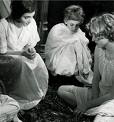 Though I've never met Guy Maddin, I think it's safe to say he has issues. This view is formed not only from Brand Upon the Brain, his latest work, but also my attendance at his birthday party at this year's Berlinale. This was a very public event hosted by Cheap, at which Marie Losier premiered Manuelle Labour, a faux silent featuring her giving birth to Guy Maddin's hands, the result, she explained, of her wanting to do a portrait of him.
Though I've never met Guy Maddin, I think it's safe to say he has issues. This view is formed not only from Brand Upon the Brain, his latest work, but also my attendance at his birthday party at this year's Berlinale. This was a very public event hosted by Cheap, at which Marie Losier premiered Manuelle Labour, a faux silent featuring her giving birth to Guy Maddin's hands, the result, she explained, of her wanting to do a portrait of him. If this wasn't startling enough, Maddin was as surprised as any of the onlookers when he was presented with a cake and forced to exorcise the painful childhood memory of being terrorised by a monkey at a birthday party. This was accomplished via a series of silent film titles, filmmakers dressed as monkeys and, back in the Cheap Gossip studio, a quick number on a piano--Marlene Dietrich's piano, no less, specially wheeled in for the occasion from the adjacent Film Museum. The cake was then smashed on the floor.
At the Berlinale, Brand Upon the Brain was given a gala staging with musicians and live voiceover by Isabella Rossellini. At the LFF it is playing as a standard film, but is still enormously inventive, witty, beautifully executed and clearly the product of a delightfully twisted mind.
A man, called Guy Maddin, returns to his childhood home on an island, after an absence of 30 years, summoned by his mother to give the lighthouse two coats of paint. Most people's memories of childhood are charged enough, but poor Guy has quite a lot of baggage to unearth, as his memories emerge over 12 chapters. His mother ran an orphanage while his father carried out mysterious experiments in the lab. When teen sleuth Wendy Hale arrives on the island, all kinds of passions are unleashed, all under his mother's omnipotent gaze, equipped with the lighthouse searchlight and the aerophone, which she uses to keep tabs on eager-to-please Guy and his sister.
Mother and son have an unsettlingly close relationship and all kinds of dynamics within the family are hinted at. Guy and his sister Sis end up vying for the attentions of Wendy, who disguises herself as her brother Chance and confuses everyone. So, in the midst of a lot of sci-fi hokum and family melodrama, a very sweet lesbian romance unfolds, leaving Guy on the sidelines.
All of this is accomplished in Maddin's signature faux-silent style, with voiceover, intertitles, asynchronous sound, no dialogue and vignetted black and white photography.
Much black and white photography is on display in Black White and Gray (dir James Crump), a documentary on the life of New York art curator/collector Sam Wagstaff, a powerful figure in the 1970s who is almost forgotten now, unlike his protégé and lover Robert Mapplethorpe. It was Wagstaff, 25 years older, who promoted Mapplethorpe and drove up prices for his work. Wagstaff also left much of his enormous wealth to Mapplethorpe, who profited greatly from the relationship.
In fact, there are those in the film who suggest Wagstaff was nothing more than a convenient sugar daddy for Mapplethorpe. By contrast, Patti Smith, who lived with Mapplethorpe when he met Wagstaff, insists that the photographer loved Wagstaff and she paints a picture of a threesome who all got along, despite the differences in their backgrounds and outlooks. Wagstaff came from a privileged Ivy League background, whereas Mapplethorpe was more rough around the edges.
As a curator, Wagstaff favoured modern art and hated photography until he had a change of heart and pursued his interest in voracious style. It is suggested that he was a collector of people as well as art. And so the two formed an alliance that lasted until their deaths from AIDS in the late 80s, during which time Wagstaff changed from a Brooks Brothers suit-wearing establishment figure to a leather-jacket wearing habitué of the meat-packing district.
The doc features work by artists favoured by Wagstaff, such as Tony Smith and Mapplethorpe, as well as interviews with various art world figures from New York and London and a few archive clips of Mapplethorpe and Wagstaff. Wagstaff's photography collection is now owned by the Getty Museum.
No comments:
Post a Comment